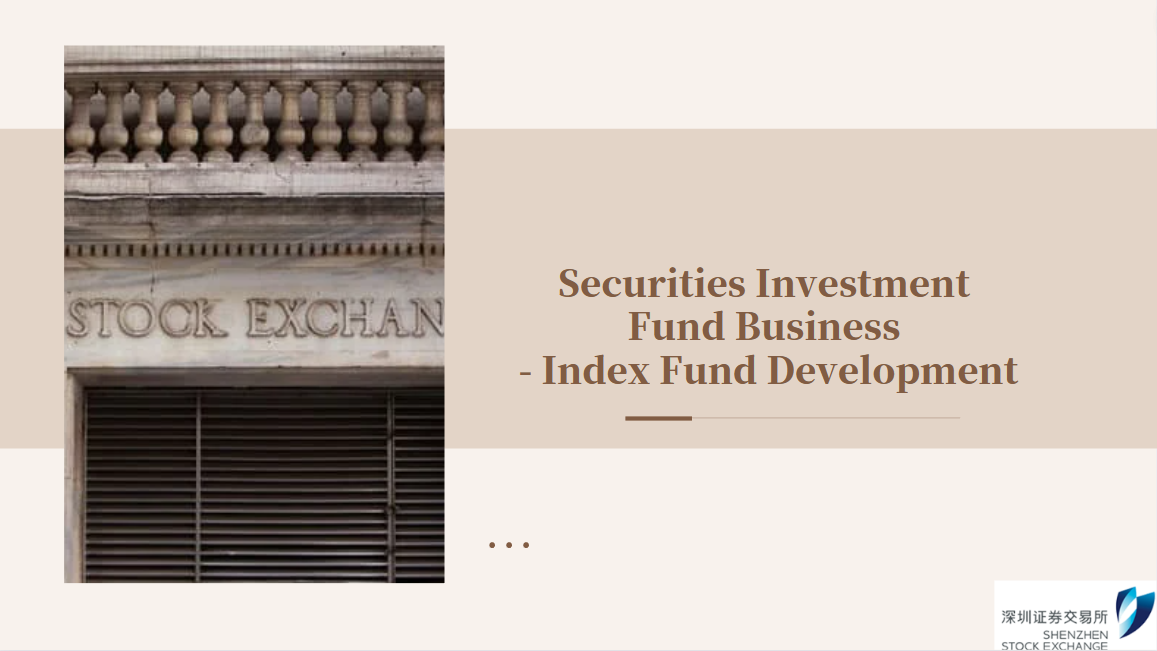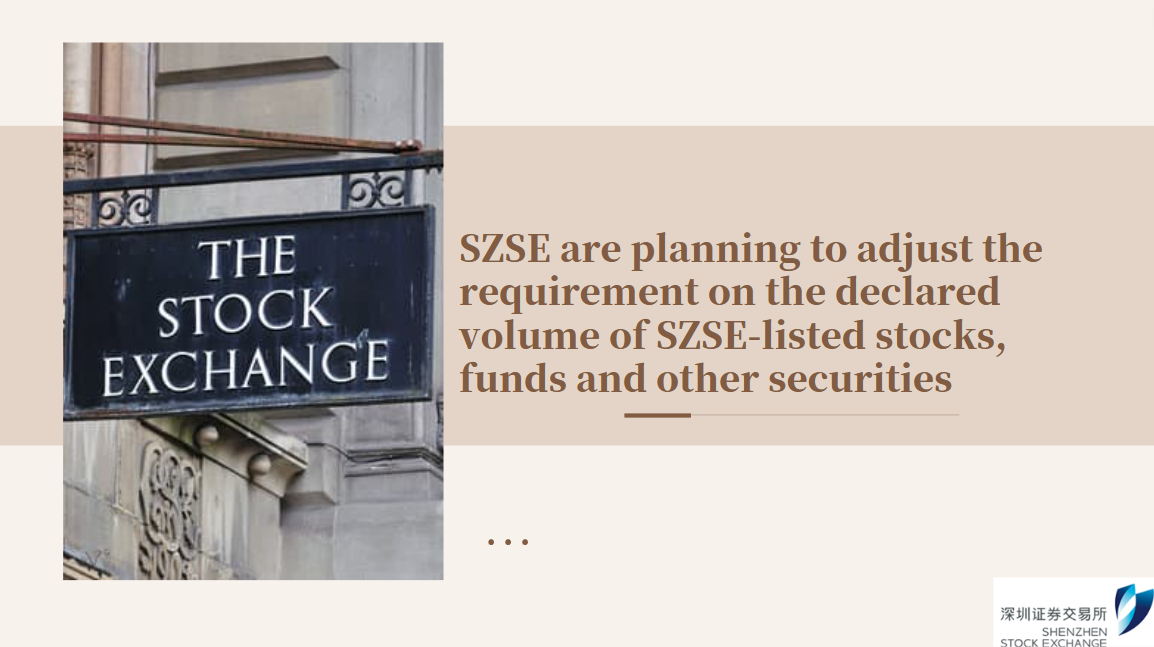Establishing Program Trading Reporting System and Regulatory Arrangements to Promote the Standardized Development of Program Trading
On September 1, Shenzhen Stock Exchange (SZSE) issued the Notice on Matters Related to Stock Program Trading Reporting (the “Reporting Notice”) and the Notice on Matters Related to the Strengthened Management of Program Trading (the “Management Notice”). These notices expanded the program trading reporting system from convertible bonds to stocks, funds and other trading instruments. They further improved the reporting and management system for program trading, maintaining the stability and healthy development of the securities market. The Reporting Notice and the Management Notice will be implemented simultaneously starting from October 9, 2023. This initiative of SZSE is in line with the requirements of the new Securities Law and responds to market demands. It represents a measure to deepen institutional innovation in key areas and helps to enhance market transparency, promoting the standardized development ofprogram trading.
In recent years, with the rapid development of new-generation information technology and financial innovation,program trading has gradually become one of the important trading methods for investors in the domestic securities market. From overseas experience,program trading has played a positive role in improving trading efficiency, enhancing market liquidity and other aspects. However, in specific market conditions, it may also exacerbate market volatility. The new Securities Law has, for the first time, made provisions onprogram trading and explicitly required program trading investors to report to the securities exchanges, ensuring that its hall not affect the security of exchange systems and normal trading order. This is also a common practice in international markets. Under the unified leadership of CSRC, SZSE proactively adapts to the new situation, tasks and requirements of market development. On February 5, 2021, SZSE issued the Notice on Matters Related to ProgramTrading Reporting for Convertible Corporate Bonds in the convertible bond field, taking the lead in piloting the program trading reporting system. Since its implementation,the program trading reporting for convertible bonds has been steadily progressing, with active cooperation from relevant parties, and the effectiveness of the system operation has begun to show. This has provided a beneficial foundation for extending related experiences and practices to other trading instruments such as stocks and funds. In February 2023, SZSE revised its Trading Rules to make principled provisions onthe program trading reporting system, ensuring a smooth connection to the newSecurities Law. This has laid the groundwork for the issuance of the Reporting Notice and the Management Notice.
These two notices aim to implement the requirements of the new Securities Law and SZSE’s Trading Rules by establishing aprogram trading reporting system and corresponding regulatory arrangements. Based on an understanding of the fundamentals of program trading and drawing on regulatory experiences from mature overseas markets as well as preventing potential risks, the notices explicitly identify key monitoring areas in program trading supervision, including abnormal program trading, high-frequency trading and substantial program trading participation in the periods having significant anomalies in the trading price and volume of multiple securities. However, the identification and handling of abnormal trading behaviors will still follow the rules stipulated by SZSE, such as the publicly availableTrading Rulesand the Real-time Monitoring Measures for Abnormal Stock Trading on the Mainboard and ChiNext Board. No new types of abnormal trading behavior specific toprogram trading have been added, nor has any program trading pattern that complies with current business rules been prohibited. During the formulation of the notices, SZSE conducted multiple seminars and research toactively solicit opinions from various stakeholders.Basedon a thorough analysis of the experience gained from convertible bond program trading reporting and the beneficial practices in managing program trading in mature overseas markets,SZSE has comprehensively improved the reporting system and supporting arrangements.
The Reporting Notice specifies the specific requirements for program trading reporting in the Shenzhen market. Firstly, it clarifies the reporting entities. The definition of program trading is established, andso it is with the scope of reporting entities which include member clients, members engaged in such businesses as proprietary trading, market making and asset management, other investors such as fund management companies and insurance institutions who trade via the exchange trading units, and other program trading investors recognized by the exchange. Secondly, itidentifies the reporting methods and time requirements. Member clients are required to report to the member who receives their trading orders and the members should promptly confirm receipt of client reporting information and report to the exchange within five trading days. Members and other organizations using trading units should report to the exchange before initiating stock program trading for the first time. Thirdly, it establishes the information of reporting which includes basic account information, account fund information, trading information, trading software information, etc. Fourthly, it strengthens the management of high-frequency trading. It explicitly states that investors meeting certain standards for the highest declaration rate or daily maximum number of declarations should provide additional reports on the location of the program trading system server, system testing reports, emergency plans in case of failures, etc. Different arrangements are made for split order algorithms used by certain institutional investors to reduce market impact from large orders or to ensure fairness in trading different investment portfolios. Fifthly, it clarifies the responsibilities of members. Members should establish internal management systems and processesfor program trading reporting, sign relevant supplementary agreements with clients to define the rights and obligations related to program trading matters. Members are required to fully verify clients report information, strengthen program trading monitoring and surveillance, and effectively carry out related work in stock program trading reporting. Sixthly, it provides clear regulatory requirements. The stock exchange will regularly conduct data screening and compare the reported information and will prompt and remind investors who have reported incomplete or inconsistent information or who fail to report as required. Self-regulatory measures may be taken depending on the situation. For cases where reporting obligations are not fulfilled,program trading is conducted without proper reporting, or member fails to fulfill reporting management responsibilities as specified in the Reporting Notice, self-regulatory measures or disciplinary actions will be taken according to self-regulatory rules. Seventhly, it specifies the scope of application for the reporting system. Investors engaged in program trading in the SZSE-listed fund and depositary receipt markets are required to comply with reporting obligations.
The Management Notice primarily strengthens the management of program trading and complements the Reporting Notice to form a foundational regulatory framework for program trading supervision. Firstly, it emphasizes the clear responsibilities of members in managing program trading. Members are required to enhance their own program trading behavior management as well as that of their clients. They may take measures such as refusing program trading orders or revoking related declarations for clients who may affect the security of the trading system or disrupt normal trading order. Secondly, it specifies key monitoring areas for program trading. It lists the stock exchange’s key monitoring areas for program trading investors, including abnormal trading behavior, high-frequency trading behavior and situations where program trading is significantly involved during the significant anomalies in the trading price or trading volume of multiple securities. Thirdly, it clarifies that the stock exchange can propose differentiated management requirements for high-frequency trading. These include adjusting the criteria for identifying abnormal trading and increasing the reporting content of program trading. Fourthly, it defines regulatory requirements.
The stock exchange may conduct on-site or off-site inspections of entities related toprogram trading as needed for self-regulation purposes. In cases where relevant entities engage in abnormal trading behavior, violateprogram trading reporting requirements, fail to comply with the management requirements specified in the Management Notice or commit other violations,the stock exchange may take self-regulatory measures or disciplinary actions.
Moving forward, SZSE will adhere to the principle of seeking progress while maintaining stability.We will continue to focus on the construction of basic regulatory arrangements in accordance with CSRC’s unified deployment to ensure that all market participants strictly adhere to the program trading reporting system and regulatory arrangements. We will continuously strengthen the surveillance of market trading behavior and protect the legitimate rights and interests of investors to effectively maintain a sound and healthy market order and ecosystem.






















































First, please LoginComment After ~